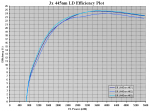Seconded... welcome to the 445nm party, IgorT!
Incidentally, Igor, do you think that you can still say "no duty cycle" about these beasts in your hosts? I'm planning a build of my own in a substantially larger host (a PGL-III-C), and may boost my target power if 1W is still reasonable in builds the size of yours.
Thanks! :yh:
That is a good question. I haven't finished testing it just yet, i also plan to put the module into an aluminum host of the same model to compare thermal dissipation into air - the alu one is black so it might even radiate more heat away instead of mainly cooling from convection (mirror polished stainless steel can't radiate as much).
As for the duty-cycle question, i'll put it like that. As long as the head of the laser is not too hot to touch i am not worried. In the projector these diodes operated at 70°C if i'm not mistaken.
And so far the laser easily took any kind of my (ab)use (and i used it quite extensivelly for long periods of constant ON).
It did get very hot quite fast - much hotter than anything else i've ever built obviously. But if i touched the head with my lips it still wasn't too hot to touch. (unfortunatelly i can't use my IR thermometer on stainless steel...)
What i'm trying to say is that i haven't (yet?) imposed any limits on it's duty cycle and still haven't noticed a problem.
But the final answer will come from a Po over Time graph and a comparison between the SS and alu hosts powering the same module.
For now i am pretty certain of the following:
- My previous builds including a couple of 12x's i made for members of the forum managed to radiate the heat away fast enough that they could even be left ON for half an hour if not even permanently without damage to the diode.
- While the Stainless Steel 445nm did not frighten me with heat yet i do not believe it could be left ON for half an hour straight. It does create 3.3W of heat (
4.5W in minus
1.2W out)! But as long as i can hold it in my hands without getting burned i am not worrried about the diode.
I also put thermal paste where the module is squeezed between the lip of the head and the middle part of the host body, to lead as much heat down into the handle as possible.
Like i said, for now i used it without any restrictions and haven't noticed a problem even tho it does get very hot (in human terms).
The only real problem i am having now is the extremelly rapid battery drainage. The voltage quickly falls below the minimum required for the driver to keep the current steady. But even this doesn't bother me too much as i always have a couple of batteries in my charger.
Obviously a larger 18650 battery host will keep it cooler with a larger heatsink, but the main benefit there is that you don't have to constantly replace the battery.
Basically i believe it is safe to use a 14500 host, as long as you don't run it past the point where the head is too hot to hold, but the power stability will be lower than in a 18650 host for obvious reasons.
I'll definitelly post my findings in a separate thread, once i do more extensive tests.
Otherwise i am getting 1.190W out of it at 1A, not just 1W. You can definitelly go further than that in a larger host as long as the driver can deliver that current (i have plans of using two drivers in parallel in an 18650 host if it turns out that 1.5A is still "safe")...
VERY IMPORTANT FOR ACCURATE CURRENT SETTINGS ON THE MicroBoost DRIVER:
If using a MicroBoost driver close to it's limits one HAS to do it with the dummy's Vf AS CLOSE AS POSSIBLE to the actual Vf of the diode (or a slightly lower dummy Vf just to be sure!) while powering the driver from a PSU set to 4.2V!
This is because at such HUGE currents, the driver can and will drop in current slightly as the battery voltage decreases (or as the voltage it has to put out increases)....
That means it's possible that if you set the driver to 1A on a dummy which has a Vf higher than your LD, the current through the LD could end up being higher than it was set to on the dummy! That's because you could have set the actual current higher than what you measure on the dummy, but this actual higher current setting would be easier for the driver to reach, once it was on the LD with it's lower Vf! It could end up pumping the lower Vf diode with the current you actually set it to - the "dropping out" (at higher dummy Vf) could cause that you unknowingly set the actual current considerably higher than you think, but you'd only see 1A for example, because that's all the driver could give out at the higher dummy forward voltage.
I do hope i explained this clearly enough. :yabbem:





